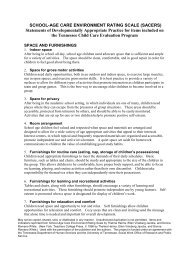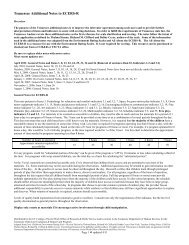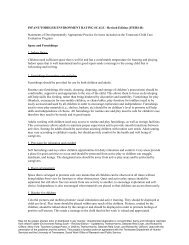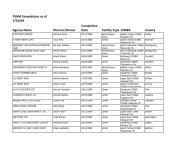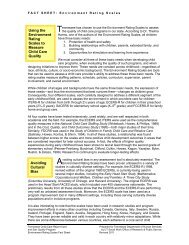ECERS-R - Star-Quality Program
ECERS-R - Star-Quality Program
ECERS-R - Star-Quality Program
Create successful ePaper yourself
Turn your PDF publications into a flip-book with our unique Google optimized e-Paper software.
13. Health practices<br />
Practicing preventive measures, such as washing hands after handling pets or wiping noses, help to<br />
educate children to achieve life-long health practices. Taking appropriate action when children are<br />
sick will minimize the spread of germs.<br />
14. Safety practices<br />
Protecting children is critical in providing quality care, whether through adequate supervision or<br />
minimizing hazards both inside and outside. Caregivers should anticipate potential safety problems<br />
and demonstrate, model, and teach children safe practices.<br />
Language-Reasoning<br />
15. Books and pictures<br />
The use of books and pictures is an important means of learning for children as they make sense of the<br />
world around them. Books, pictures, and language materials should be available in sufficient number<br />
both for independent use in a reading center and for use by a teacher with children in formal and<br />
informal settings.<br />
16. Encouraging children to communicate<br />
Activities and materials that promote language development should be available for use throughout the<br />
classroom and the daily schedule. Teachers should establish an environment where language<br />
exploration and usage is encouraged.<br />
17. Using language to develop reasoning skills<br />
Logical relationships and concepts should be presented in appropriate ways. Children learn through<br />
interaction with materials and people, both peers and adults, in the context of play and daily routines.<br />
Language provides the key tool for success and problem solving, as children are encouraged to talk<br />
through their thought processes.<br />
18. Informal use of language<br />
Language is a way for children to expand understanding. Caregivers should engage children in give<br />
and take conversations for enjoyment and learning. They should support child-to-child conversations<br />
as well.<br />
Activities<br />
19. Fine motor<br />
Children need a variety of age-appropriate and developmentally-appropriate toys and materials that<br />
they can manipulate with their hands and play with at will. These activities strengthen fine motor<br />
control while encouraging skill development that contributes to academic readiness.<br />
May not be copied, shared, sold, or distributed in any manner. Unauthorized duplication is not permitted.<br />
Items and indicators reprinted from Early Childhood Environment Rating Scale – Revised Edition – Updated<br />
by Thelma Harms, Richard M. Clifford, and Debby Cryer. (New York: Teachers College Press, 2005 by<br />
Thelma Harms, Richard M. Clifford, and Debby Cryer.) Used with the permission of the publisher and the<br />
authors. This project is funded under an agreement with the Tennessee Department of Human Services<br />
and the University of Tennessee, Social Work Office of Research and Public Service.




